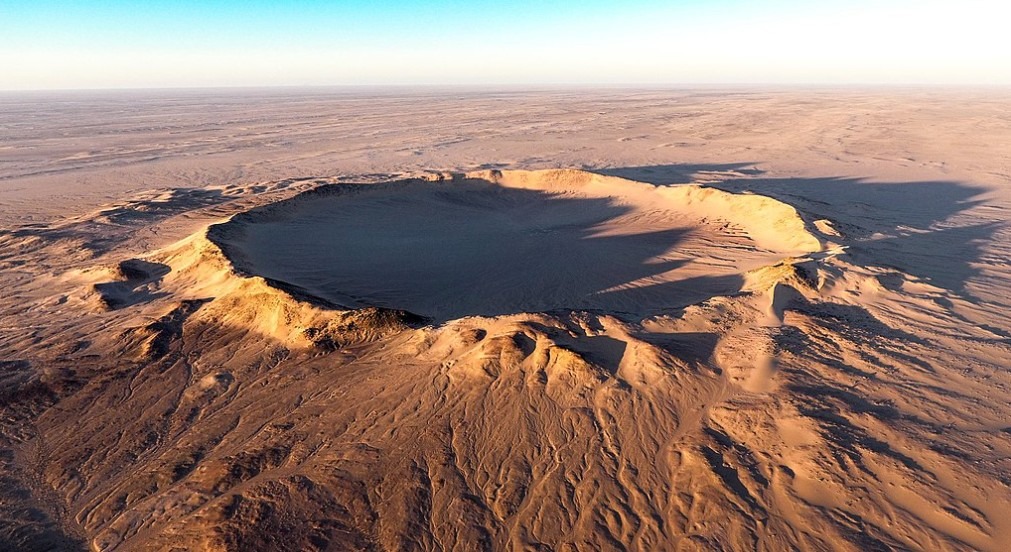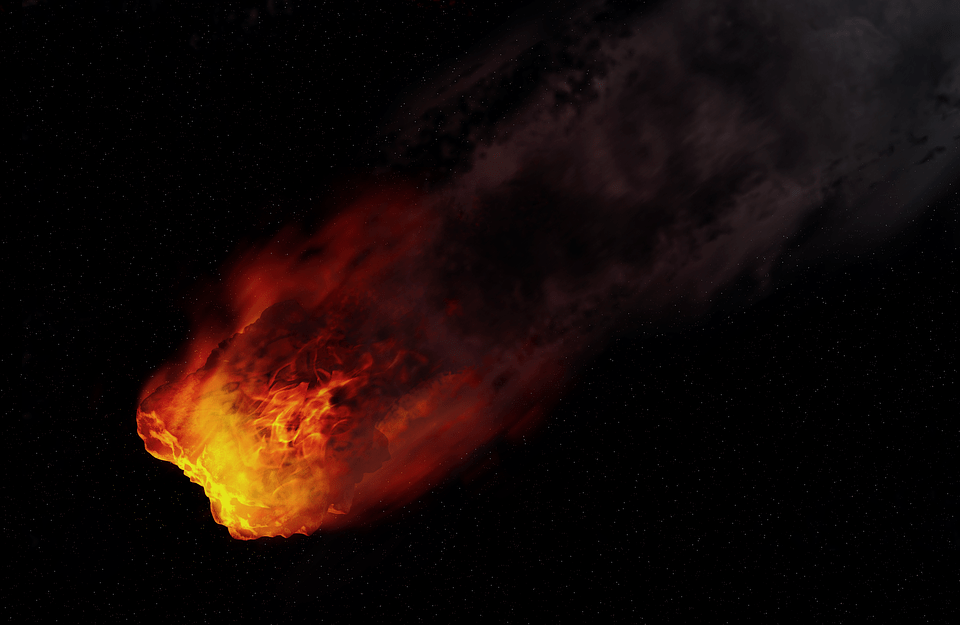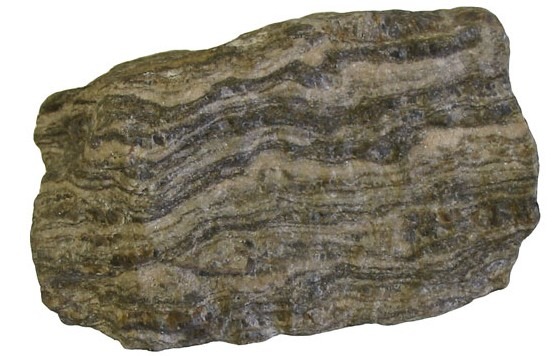Tenoumer Crater is a confirmed crater deep in the Sahara Desert. It is a near-perfect circular crater. The diameter of the crater is 1.2 miles (1.9 km) with a depth of 100 meters (330 feet). According to NASA’s Earth Observatory, the origins of the crater have long been debated among geologists. However, it is estimated that the impact crater is 10,000 to 30,000 years old. Furthermore, the floor of the crater is filled with a thick layer of sediments approximately 200 to 300 meters (660 to 980 feet).
The remote location of the impact crater makes it one of the most difficult crater sites to visit. Even from the Mauritania capital, Nouakchott, it takes approximately 11 hours to reach the nearest town of Zouerat or Fderik which is still 124.27 miles (200 km) away from the crater. If you are willing to visit Tenoumer Crater, then you must be adventurous.
Formation of Tenoumer Crater
The diameter of this surprisingly circular crater is 1.2 miles (1.9 km). The crater rim rises about 110m (361 feet) around the surroundings. According to the research, the crater is filled with a layer of unconsolidated sediments about 200 to 300 meters (656 feet to 984 feet) thick. Therefore, the Tenoumer Crater is an impressive structure even than the famous Barringer Crater in Arizona, USA.
The meteorite struck a very hard rock in the Sahara Desert made up of Precambrian granites and gneiss (Reguibat shield) 3.5 billion years old. They are covered with a thin crust of weathered rock. However, it is hard to comprehend the power of an explosion that blasts and melts thousands of tons of such hard stone.
The inner slopes of the Tenoumer Crater are very steep. There are scattered fragments of the molten rock around the crater, mainly to the east, southwest, and northwest. The pieces are 20 meters (66 feet) long and contain small inclusions of fractured glass. Furthermore, other deformations of the rock grains are under observation.
However, no pieces of meteorite have been found. When a meteorite or comet from our solar system hit the Earth’s surface, it is estimated that it vaporized due to heat and energy produced during an impact. Also, there are no traces of meteorite in the surrounding rocks near the Tenoumer Crater site.
Three Meteorites At Once Or Three Different Events
Mauritania has several impact craters which are surprisingly aligned on a line such as Aouelloul Crater, Tenoumer Crater, and the Temimichat-Ghallaman Crater. It is estimated that all three craters were created by a single catastrophic meteor shower.
However, later research shows that this is not true. The Aoullelour Crater is the oldest among the three of them which is approximately 3.1 million years old. The age of the Temimichat-Ghallaman is still not known. Also, it is like one of the craters on Earth such as Pingualuit Crater, if it is an impact or volcanic crater. The Tenoumer Crater, on the other hand, is relatively younger, approximately 21,400 years old.
Scientific Significance of Tenoumer Crater
Tenoumer Crater with a perfect circular shape has been well known to the local populations. Also, it has been known to the Europeans since antiquity. In the early 1950s, scientists began to wonder if this crater had been formed by a meteorite or a volcano.
At first, basalt-like rocks and rhyodacite scattered around the crater gave the impression that it was an ancient volcano. In 1970, compelling evidence was discovered for a meteorite impact when key external impact features such as plane strain features were found in the putative lava. Since then, Tenoumer Crater was declared an impact crater caused by a meteorite impact.
Age Of Tenoumer Crater
A variety of molten rock fragments were found along the rim of the Tenoumer Crater and on the outer slope. The chemical composition of the rocks ranged from andesitic to rhyodacite. Later on, the chemical diversity of the molten rocks was attributed to varying proportions of no less than six different basement lithologies.
The first report of evidence of shock in the form of abundant planar deformation features (PDFs) in granitic quartz gneiss and grain fragments in the molten rocks concluded that they were melted by an impact. In the earliest reports, the age of the Tenoumer Crater was estimated to be 2.5 million years old.
However, it was then estimated that Tenoumer Crater was only 21,000 years old. The younger age was obtained by analysis of apatite fission tracks from the molten rocks. The character of the molten rocks was described as fine-grained intergrowths of pyroxene, oxide (magnetite), and plagioclase crystals with interstitial glass.
The age of the Tenoumer Crater has been a debate like other craters on earth such as the Wolfe Creek Crater. However, the estimated and confirmed age of the Tenoumer Crater is 10,000 to 30,000 years old.
Petrographic and Petrologic Description
Larger molten rock specimens having a diameter of more than 15 cm are ovoid while the smaller ones less than 10 cm in diameter are in an irregular shape. All the molten rocks collected from the Tenoumer Crater are composed of 50 to 90% by volume aphanitic silicate matrix. They contain 10 to 40% by volume of round vesicles. Furthermore, there are deposits of 15% by volume droplets of schlieren and carbonate with 1 to 10% in volume of mineral and lithic clasts.
According to a study, all these types of impact-related rocks are classified as molten impact hypo crystalline rocks. The samples collected from the Tenoumer Crater appear fresh which means there are no obvious signs of weathering. However, all analyzes were carried out 0.5 cm below the outer surface of the samples.
Visiting Tenoumer Crater
Tenoumer Crater is in the Sahara Desert which makes it a remote site to visit. However, if you still want to visit Tenoumer Crater, you will need to get there on your own. From the Mauritania capital, Nouakchott, it takes 11 hours to drive to the nearest town of Fderik. If you are traveling by air, then it will take 2 hours to reach Fderik from Nouakchott.
Once you have reached Fderik, you can get local directions. Also, you have to make sure that the destination is written in Arabic to indicate if you need assistance.
Tenoumer Crater – A 10,000 to 30,000 Years Old Impact Crater
When you see Tenoumer Crater from satellite imagery, it will make you think about how a meteorite formed a perfectly circular impact crater. It is one of the top 10 craters on Earth that has been a topic of dispute if it is a volcanic or impact crater. However, researchers have confirmed Tenoumer Crater as an impact crater that was formed 10,000 to 30,000 years ago. Furthermore, it is one of the younger craters in the history of impact craters on earth.
Tenoumer Crater has been a center of attention for researchers and geologists. Some of them believed it was a volcanic crater. However, the sediments and fragments collected from the Tenoumer Crater site helped the geologists to know the origin of the impact crater. Visiting Tenoumer Crater is not as easy as it seems to be. It is located in the remote location of the Sahara Desert. For this purpose, you can reach the nearest town of Fderik by road or air and then start your adventure to Tenoumer Crater.






